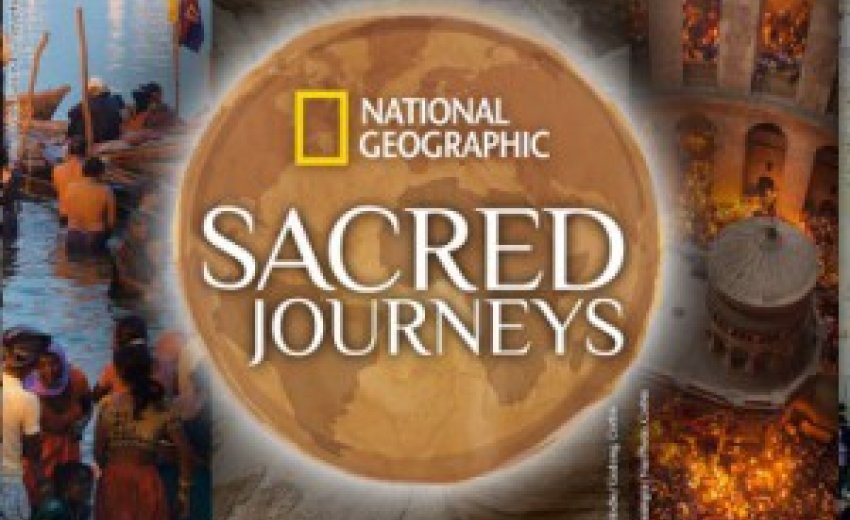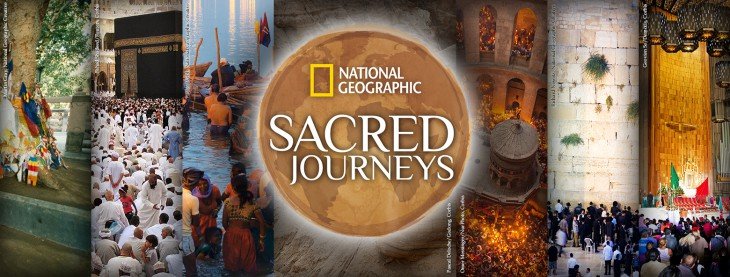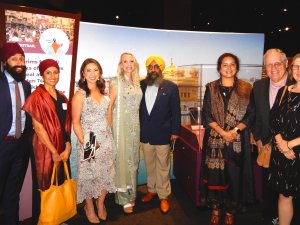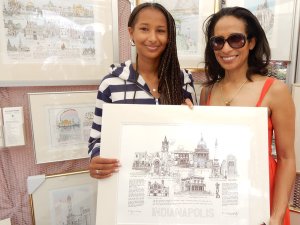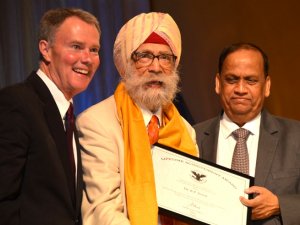|
Prayerful Reflection:
What one sees at the “National Geographic Sacred Journeys” Exhibit that opened on August 29'1’ at the Children’s Museum of Indianapolis is only one part; what the treasured iconic images and artifacts inspire in our heart and the "pilgrimage” into our deeper self may transform our perceptions and relationships with others may be the real major blessing and sure to initiate interfaith events and journeys of discovery closer to home. That will define the ultimate gift and triumph of the “Sacred Journeys” Exhibit, annual Indy Festival of Faiths, other faith-based efforts, and lead us to learn about and respect this diversity as an important dimension and spectrum of our humanity.
ENRICHING, REWARDING, AND INSPIRATIONAL
The Sacred Journeys Exhibit at the Children's Museum in Indianapolis is a carefully- choreographed window to some selected panels of sacred heritage and faith traditions. For families, teachers, faith communities and civic leaders, the Exhibit offers illuminating insights, large photographic images, a thoughtful invitation to learn about the faiths of our neighbors who live, share, and contribute to the richness of the cultural landscape and spiritual fabric of our world. The vision and spirit of the Exhibit is an interfaith living experience, a pilgrimage of spirit in a beautifully created classroom, rich in symbolism, graphics, and imagination to enlarge our understanding about some venerable traditions and facets of major faiths that form the collective spiritual heritage of humanity.
The Exhibit provides a glimpse, a first glance: The carefully laid-out beautiful displays seeming much like the stations of faiths, supported with videos, interactive elements, iconic sacred attractions representing the Christian, Moslem, Hindu, Buddhist, Sikh, Mormon, Australian Aborigines, and others; take us on a pilgrimage of their own. There arc religious scriptures, precious documents and sacred objects: a block of stone from the Western Wall in Jerusalem; a 500-year old Quran, a statue of a Hindu deity Lord Ganesha; the teaching throne of His Holiness the Dalai Lama and a Peace Mandala; giant photographs of the Church of the Holy Sepulcher, an Ethiopian Cross, and fragments of Dead Sea Scrolls; a beautiful model and drawing of the Golden Temple of the Sikhs; and much, much more. There is a quiet room for slides of world sacred sites, for meditation, reading, music, story-telling of unique and moving spiritual experiences. The Eli Lilly Endowment Inc. is the principal sponsor of the Exhibit. Visitors would be proud of the time, labor, sensitivity, and reverence invested by the Museum staff and advisers to prepare the Exhibit. “Sacred Journeys” continues through February 2016 and then will travel to other cities.
A CELEBRATION OF FAITHS, CULTURES, AND TRADITIONS
The literature accompanying the Exhibit states: “Each year, more than 330 million people around the world— from all walks of life—journey to a sacred place. Through awe-inspiring immersive environments created with photography from National Geographic, families will be able to observe, discuss, and begin to understand some of the sacred journeys made by people around the world, from personal acts of faith to pilgrimages. Sacred journeys include the Western Wall in Jerusalem, the Great Mosque in Mecca, the Ganges River in India, Bodh Gaya in India where Buddha is said to have achieved enlightenment, the Basilica of Our Lady of Guadalupe in Mexico City, and more. Artifacts from a variety of faith traditions will enrich the experience.”https://www.childrensmuseum.org/sacred-journeys
The slide presentation takes us to innumerable places and sites of pilgrimage scattered across our earth, though human imagination and spirit about things and places that arc sacred is not bound by temporal limits and visual markers. Some of these places of pilgrimage are modest, others are opulent and breathtaking; they all evoke deep reverence and powerful emotions for the faithful because of their history and sanctified by association with the lives and times of Divine Messengers, history and journey of faith and its followers, dedicated to martyrs of righteous defiance and other significant events.
Pilgrimage and sacred sites carry fascination for us because of their resplendent beauty, architectural grandeur, amazing art, breathtaking embellishments, awe-inspiring settings, unique history and traditions.
In their simplicity or resplendent majesty, these “Cathedrals of Spirit” have been and continue to be venerable stations of the faiths, centers of pilgrimage for generations of humanity. They are located along the rivers, lakes, and oceans; in valleys and on mountain top; in remote areas and amidst urban sprawl. They are man-made and natural; defy human imagination and creative daring. The human spirit surrenders at their majesty and sacred association. Among them arc hallowed grounds for all humanity, for they represent ideas and ideals that are universal in spirit and intention. People have brought their prayers, concerns, gratitude, and contributed to the spiritual aura of these sites. They evoke images, emotions, and reverence:
Saint Peter’s and Vatican in Rome, Notre Dame Cathedral in Paris, Mont Saintc Michelle in France, Gaudi’s Sagrada Familia in Spain (Catholic); The Church of the Holy Sepulcher (Christian); The Western Wall (Jewish) and The Dome of the Rock (Moslem) in Jerusalem; Mecca in Saudi Arabia (Moslem); Benares Ghats on the River Ganges, Madurai Temple (Hindu) in India; The Golden Temple at Amritsar, Takht Sri Kesgarh Sahib at Anandpur, Hemkunt Sahib in the Valley of Gods (Sikh); Bodh Gaya in India, Kamakura Buddha in Japan, and Angkor Wat in Cambodia (Buddhist); National Cathedral in Washington, D.C. (non-denominational); and thousands of celebrated and designated sights that are part of humanity’s sacred journeys and heritage.
These reflect man’s creative genius; primordial urge, devotion and dedication to know and reach for something Higher, liberating and emancipating beyond this life. Pilgrimage sites symbolize something transcendent, making millions embark on sacred journeys every year in search of something so deeply enshrined in the human soul and intergenerational memory. Sacred Journeys are an act of renewal, a prayer to reconnect with their deeper self and anchors of faith.
The Exhibit is focused on an educational vision, culturally unintrusive, yet invitational and inspiring to enlarge our understanding of the world of faiths and cultures around us; to develop greater appreciation of our own and others that form the tapestry of faiths that enrich our universe. We hope that in time, we will dispel unfounded stereotyping and suspicions about others and see our collective heritage as an amazing library of spiritual knowledge and treasured heritage to exalt our understanding of ourselves as a member of "One Family, One Race,” placed on this Earth to make us a Planet of peace amidst the vast unfathomable cosmos. This unifying precept may begin with an Exhibit, an Interfaith Festival, a gathering at a cathedral, but each generation has to move this frontier to where we see each other as One God’s Children who is the Father and Mother of All Creation, and we, and what all we see, believe, and imagine as a part of His Wondrous Manifestation.
REFLECTING ON THE SIGNIFICANCE OF SACRED JOURNEYS
The “National Geographic Sacred Journeys” is an invitation: We are encouraged to go on our own faith journeys, pilgrimages to sacred sites around the world and right in our own communities.
Each person will see the “Sacred Journeys” Exhibit through their own spiritual and cultural lens. I saw the Exhibit as an illuminating “Cathedrals of Spirit,” not just a KP Singh composite drawing with the same title. As I stopped and reflected at each of the displays laid out in an intimate fashion, I saw the journey of faiths as uplifting encounters with high holy places, venerable sacred texts with unifying precepts and lessons, magnificent architecture, and breathtaking repositories of art. Fascinating visuals, the interactive stations; videos of Hajj of Muslims at Mecca in Saudi Arabia; Kumbh Mela of Hindus at Allahabad; the storytelling about the holiest Jewish site, the Western Wall in Jerusalem; the place of enlightenment of Lord Buddha at Bodh Gaya; the Golden Temple of the Sikhs, Angel Maroni of the Mormon faith; Christian sites, ancient Dead Sea Scrolls, Aborigines’ paintings, offer a glimpse of the sacred and distinct.
“Sacred Journeys” is especially important for children. In today’s multicultural society, schools, workplaces, an increasingly interdependent and interconnected world, it is important that we know about other cultures and neighbors. If for no other reason, then at least to develop respect: end suspicion, unfounded stereotyping, prejudice; problems of mistaken identity and wrongful associations that are causing many challenges for Sikh Americans and others. “Sacred Journeys,” Festival of Faiths, myriad interfaith events and initiatives that support worthy causes arc a starting point. I saw creating a positive environment as greatly enlarging our collective wellbeing and blessings at multiple levels: dispelling fear and hatred of the unfamiliar; education in safe classrooms; networking at interfaith celebrations. Learning about traditions different from our own must never be a threat to one’s faith heritage, spiritual associations, and values. I saw “Sacred Journeys” as a prism to distinct faith-journeys at our common crossroads converging at the same Immaculate Destination.
“Sacred Journeys” helped my understanding and awareness. It did not intrude upon faith precepts, commandments, and traditions. The amazing research that has gone into the identification and authentication of the Shroud of Turin (replica represented in the Exhibit) gave me pause about the priceless surviving artifacts and vestments of Sikh Gurus, many hand-written sacred texts, the hallowed history and heritage that presently lie in less than ideal conditions and environment - in old suitcases, closets, untended places in Sikh shrines and with people that may not fully understand their historic and timeless spiritual significance. Witnessing the care, attention, scientific and technological advancements adopted by Abrahamic faiths, gave me a jolt of urgency to draw attention to preservation, safeguarding the sacred in Sikh and other faiths. Many treasured antiquities have been victims of barbaric and senseless destruction in recent years; others face further damage and threat due to neglect, lack of funds, and accessibility to the latest preservation techniques and experts needed to save our sacred heritage for future generations.
www.KPSinghDesigns.com www.facebook.com/KPSinghIndiana November 5, 2015
| KP Singh family with Jeff Patchen, President and Jennifer Robinson, VP for Exhibits and Family Learning, of the Children's Museum |
| Sikh faith display - Golden Temple model and Drawing |
| Teaching Throne of His Holiness the Dalai Lama (L-R: KP and Robbie Singh, Ruth and Noel Yarger) |
| Jewish faith display with a sacred stone from the Western Wall in Jerusalem |
| Dome of the Rock in Jerusalem and 500 year old Quran |
| Entrance to the Sacred Journeys Exhibit Area |
| Sikh faith display - Guru Granth Sahib, sacred faith articles |
| Pilgrimage corridor - Our Lady of Guadalupe (Mexico) |
| Tashi Kyil Monks dedicating the Peace Mandala |
| Completed Sand Mandala with interfaith and other Buddhist symbols |
| Lisa Morrison, Lisa Townsend, Jeff Patchen, Arjia Rinpoche, KP Singh, Chris Carron, Chunpay |
| Venerable Arjia Rinpoche and Jennifer Robinson at the special display |
| Church of the Holy Sepulcher with Museum volunteers |
| KP Singh with Venerable Arjia Rinpoche at the Lord Ganesha display |
| Sacred Sikh artifacts for the Sacred Journeys Exhibit |
| Cathedrals of Spirit drawing by KP Singh |

